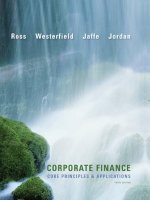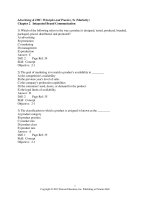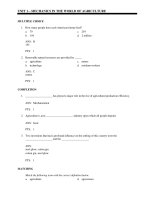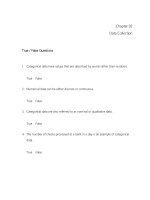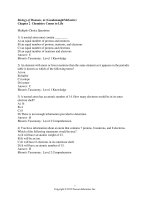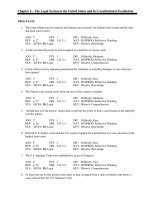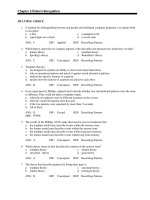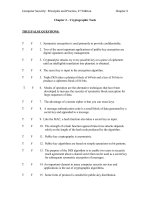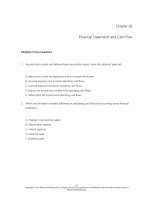Corporate finance core principles and applications 4th edition ross test bank
Bạn đang xem bản rút gọn của tài liệu. Xem và tải ngay bản đầy đủ của tài liệu tại đây (1.43 MB, 88 trang )
Chapter 02
Financial Statements and Cash Flow
Multiple Choice Questions
1.
Assume both current and deferred taxes are positive values. Given this, deferred taxes will:
A. reduce the current tax expense and thus increase net income.
B. increase expenses and increase operating cash flows.
C. increase expenses and lower operating cash flows.
D. reduce net income but not affect the operating cash flows.
E. reduce both net income and operating cash flows.
2.
Which one of these is handled differently in calculating cash flows for accounting versus financial
purposes?
A. Change in net working capital
B. Depreciation expense
C. Interest expense
D. Deferred taxes
E. Dividends paid
2-1
Copyright © 2014 McGraw-Hill Education. All rights reserved. No reproduction or distribution without the prior written consent of
McGraw-Hill Education.
3.
Which one of these will increase earnings per share?
A. Decreasing deferred taxes
B. Increasing depreciation expense
C. Lowering the operating income
D. Increasing the corporate tax rate
E. Lowering the percentage of net income added to retained earnings
4.
A current asset is best defined as:
A. the market value of all assets currently owned by the firm.
B. an asset the firm expects to purchase within the next year.
C. the amount of cash on hand the firm currently shows on its balance sheet.
D. cash and other assets owned by the firm that will convert to cash within the next year.
E. the value of fixed assets the firm expects to sell within the next year.
5.
The long-term debts of a firm are liabilities:
A. owed to the firm's shareholders.
B. that do not come due for at least 12 months.
C. owed to the firm's suppliers.
D. that come due within the next 12 months.
E. the firm expects to incur within the next 12 months.
6.
A(n) ____ asset is one which can be quickly converted into cash without significant loss in value.
A. tangible
B. fixed
C. intangible
D. liquid
E. long-term
2-2
Copyright © 2014 McGraw-Hill Education. All rights reserved. No reproduction or distribution without the prior written consent of
McGraw-Hill Education.
7.
Noncash items refer to:
A. the credit sales of a firm.
B. the accounts payable of a firm.
C. all accounts on the balance sheet other than cash on hand.
D. the costs incurred for the purchase of intangible fixed assets.
E. expenses charged against revenues that do not directly affect cash flow.
8.
Your _____ tax rate is the percentage of the next taxable dollar of income you earn that is payable
as a tax.
A. deductible
B. residual
C. marginal
D. average
E. total
9.
Your _____ tax rate measures the total taxes you pay divided by your total taxable income.
A. average
B. marginal
C. total
D. deductible
E. residual
10. _____ refers to the cash flow resulting from a firm's ongoing, normal business activities.
A. Cash flow from assets
B. Net working capital
C. Capital spending
D. Cash flow from operating activities
E. Cash flow to creditors
2-3
Copyright © 2014 McGraw-Hill Education. All rights reserved. No reproduction or distribution without the prior written consent of
McGraw-Hill Education.
11. _____ refers to the changes in net capital assets.
A. Cash flow from assets
B. Net working capital
C. Cash flow from investing
D. Operating cash flow
E. Cash flow to creditors
12. _____ refers to the difference between a firm's current assets and its current liabilities.
A. Operating cash flow
B. Capital spending
C. Net working capital
D. Cash flow from assets
E. Cash flow to creditors
13. _____ is calculated by adding back noncash expenses to earnings before interest and taxes,
subtracting taxes, and adjusting for any changes in total assets or current liabilities that affect cash
flows.
A. Distributable cash flow
B. Capital spending
C. Cash flow from assets
D. Cash flow from investing activities
E. Cash flow to creditors
2-4
Copyright © 2014 McGraw-Hill Education. All rights reserved. No reproduction or distribution without the prior written consent of
McGraw-Hill Education.
14. _____ refers to a firm's interest payments minus any net new borrowing.
A. Operating cash flow
B. Distributable cash flow
C. Net working capital
D. Cash flow to equity investors
E. Cash flow to creditors
15. _____ refers to a firm's dividend payments minus any net new equity raised.
A. Operating cash flow
B. Capital spending
C. Net working capital
D. Cash flow to equity investors
E. Cash flow from creditors
16. Which of the following are included in current assets?
I. Equipment
II. Inventory
III. Accounts payable
IV. Cash
A. II and IV only
B. I and III only
C. I, II, and IV only
D. III and IV only
E. II, III, and IV only
2-5
Copyright © 2014 McGraw-Hill Education. All rights reserved. No reproduction or distribution without the prior written consent of
McGraw-Hill Education.
17. Which of the following are included in current liabilities?
I. Debt payable to a mortgage company in nine months
II. Note payable to a supplier in eighteen months
III. Accounts payable to suppliers
IV. Loan payable to a bank in fourteen months
A. I and III only
B. II and III only
C. III and IV only
D. II, III, and IV only
E. I, II, and III only
18. Which one of the following accounts is generally the most liquid?
A. Patent
B. Building
C. Accounts receivable
D. Equipment
E. Inventory
19. Which one of the following statements concerning liquidity is correct?
A. Fixed assets are more liquid than current assets.
B. Balance sheet accounts are listed in order of decreasing liquidity.
C. Liquid assets tend to be highly profitable.
D. The less liquidity a firm has, the lower the probability the firm will encounter financial difficulties.
E. Trademarks and patents are highly liquid.
2-6
Copyright © 2014 McGraw-Hill Education. All rights reserved. No reproduction or distribution without the prior written consent of
McGraw-Hill Education.
20. Liquidity is:
A. a measure of the use of debt in a firm's capital structure.
B. equal to current assets minus current liabilities.
C. equal to the market value of a firm's total assets minus its current liabilities.
D. generally associated with intangible assets.
E. valuable to a firm even though liquid assets tend to be less profitable to own.
21. Book value is:
A. based on historical cost.
B. equivalent to market value for firms with fixed assets.
C. more of a financial than an accounting valuation.
D. the amount a willing buyer will pay for an asset.
E. adjusted to market value whenever the market value exceeds the stated book value.
22. When making financial decisions related to assets, you should:
A. place primary emphasis on historical costs.
B. place more emphasis on book values than on market values.
C. rely primarily on the value of assets as shown on the balance sheet.
D. always consider market values.
E. only consider market values if they are less than book values.
23. As seen on an income statement:
A. interest is deducted from income and increases the total taxes incurred.
B. depreciation reduces both the pretax income and the net income.
C. depreciation is shown as an expense but does not affect the taxes payable.
D. the tax rate is applied to the earnings before interest and taxes when the firm has both
depreciation and interest expenses.
E. interest expense is added to earnings before interest and taxes to get pretax income.
2-7
Copyright © 2014 McGraw-Hill Education. All rights reserved. No reproduction or distribution without the prior written consent of
McGraw-Hill Education.
24. Depreciation:
A. reduces both the net fixed assets and the costs of a firm.
B. decreases net fixed assets, net income, and operating cash flows.
C. is a non-cash expense that decreases the selling, general, and administrative expenses.
D. is a non-cash expense that reduces the pretax income.
E. increases the net fixed assets as shown on the balance sheet.
25. When you are making a financial decision, the most relevant tax rate is the _____ rate.
A. average
B. fixed
C. marginal
D. total
E. variable
26. Al's has a positive net income and a tax rate of 34 percent. Given this, an increase in which one of
the following will cause the operating cash flow to increase?
A. Fixed assets
B. Taxes
C. Net working capital
D. Cost of goods sold
E. Depreciation
2-8
Copyright © 2014 McGraw-Hill Education. All rights reserved. No reproduction or distribution without the prior written consent of
McGraw-Hill Education.
27. A firm starts its year with a positive net working capital. During the year, the firm acquires more
short-term debt than it does short-term assets. This means that:
A. the ending net working capital might be positive, negative, or equal to zero.
B. both accounts receivable and inventory decreased during the year.
C. the beginning current assets were less than the beginning current liabilities.
D. accounts payable increased and inventory decreased during the year.
E. the ending net working capital will be negative.
28. The cash flow to creditors increases when:
A. cash is used to reduce accounts payable.
B. new shares of stock are sold for cash.
C. interest is paid on outstanding debt.
D. an asset is sold for cash.
E. a long-term debt is incurred.
29. Cash flow to stockholders must be positive when:
A. the net sale of common stock exceeds the amount of dividends paid.
B. no income is distributed but new shares of stock are sold.
C. both the cash flow to assets and the cash flow to creditors are negative.
D. both the cash flow to assets and the cash flow to creditors are positive.
E. the dividends paid exceed the net new equity raised.
30. Which one of these, all else held constant, will increase the value of stockholders' equity?
A. Decrease in accounts receivable
B. Increase in long-term debt
C. Decrease in retained earnings
D. Increase in accounts payable
E. Increase in fixed assets
2-9
Copyright © 2014 McGraw-Hill Education. All rights reserved. No reproduction or distribution without the prior written consent of
McGraw-Hill Education.
31. Which one of these statements is correct?
A. Long-term debt is the residual difference between assets and liabilities.
B. Net income that is not paid out in dividends decreases retained earnings.
C. Long-term debt requires a payout of cash within a stated time period.
D. Stockholders' equity is stated at market value on the balance sheet.
E. Stockholders' equity increases as the liquidity of a firm increases.
32. The carrying value or book value of assets:
A. is always the best measure of a company's value to an investor.
B. represents an average market value over time.
C. is always higher than the replacement cost of the assets.
D. is determined under GAAP and is based on the cost of the assets.
E. is determined under GAPP and is based on the current market value of the assets.
33. When evaluating a balance sheet, a financial manager should consider which of the following?
I. Value versus cost
II. Debt versus equity
III. Accounting liquidity
A. I only
B. I and III only
C. II only
D. I and II only
E. I, II, and III
2-10
Copyright © 2014 McGraw-Hill Education. All rights reserved. No reproduction or distribution without the prior written consent of
McGraw-Hill Education.
34. The income statement:
A. measures a firm's performance as of a specific date.
B. determines the aftertax income of a firm.
C. excludes deferred taxes.
D. includes dividends as an expense.
E. determines the value of a firm to its shareholders.
35. What is the formula for computing operating cash flow?
A. EBIT + Depreciation - Current taxes
B. EBIT + Depreciation - Interest expense - Taxes
C. EBIT + NWC - Depreciation
D. EBIT - Depreciation + Current taxes
E. EBIT - NWC + Depreciation - Current taxes
36. Net capital spending is equal to:
A. the net purchases and sales of fixed assets.
B. total cash flow to stockholders less interest and dividends paid.
C. net income plus depreciation.
D. the change in total assets.
E. the change in current assets minus the change in current liabilities.
37. Cash flow to equity holders is defined as:
A. the total dividends paid.
B. the cash flow from assets plus the cash flow to creditors.
C. cash dividends plus repurchases of equity minus new equity financing.
D. repurchases of equity less cash dividends paid plus new equity sold.
E. the net change in common stock and capital surplus.
2-11
Copyright © 2014 McGraw-Hill Education. All rights reserved. No reproduction or distribution without the prior written consent of
McGraw-Hill Education.
38. Free cash flow is:
A. without cost to the firm.
B. equal to net income plus taxes.
C. a term used to describe an increase in net working capital.
D. cash that is available to distribute to creditors and equity holders.
E. another term for operating cash flow.
39. The cash flow of a firm, also referred to as cash flow from assets, must be equal to the cash flow to:
A. debt holders minus the cash flow to equity holders.
B. equity holders plus the cash flow to debt holders.
C. the government plus the cash flow to equity holders.
D. equity holders minus the cash flow to debt holders.
E. the government, the debt holders, and the equity holders.
40. A change in which one of these accounts will appear as an investing activity in an accounting
statement of cash flows?
A. Accounts payable
B. Inventory
C. Interest expense
D. Fixed assets
E. Sales
2-12
Copyright © 2014 McGraw-Hill Education. All rights reserved. No reproduction or distribution without the prior written consent of
McGraw-Hill Education.
41. A firm has total equity of $1,890, net working capital of $150, long-term debt of $890, and current
liabilities of $720. What is the amount of the net fixed assets?
A. $2,330
B. $2,930
C. $2,630
D. $3,050
E. $3,350
42. A firm has beginning retained earnings of $4,200 and ending retained earnings of $4,650. What is
the amount of dividends paid if the firm earned a net income of $1,950?
A. $450
B. $1,950
C. $2,400
D. $1,500
E. $900
43. Lester's has $23,600 in sales, $13,200 in cost of goods sold, $2,300 in depreciation, $900 in interest
expense, and $6,200 in selling, general, and administrative expenses. The firm owes no taxes for this
year. What is the amount of the period costs that are included in the operating cash flow?
A. $19,400
B. $7,000
C. $9,300
D. $20,300
E. $6,200
2-13
Copyright © 2014 McGraw-Hill Education. All rights reserved. No reproduction or distribution without the prior written consent of
McGraw-Hill Education.
44. A firm has $800 in inventory, $1,400 in fixed assets, $500 in accounts receivables, $100 in net
working capital, and $50 in cash. What is the amount of the current liabilities?
A. $3,750
B. $1,350
C. $3,950
D. $1,150
E. $1,250
45. Total assets are $1,500, fixed assets are $1,100, long-term debt is $600, and short-term debt is $300.
What is the amount of net working capital?
A. $0
B. $100
C. $200
D. $300
E. $400
46. Brad's Company has equipment with a book value of $500 that could be sold today at a 50 percent
discount. Its inventory is valued at $400 and could be sold to a competitor for that amount. The
firm has $50 in cash and customers owe them $300. What is the accounting value of its liquid
assets?
A. $50
B. $350
C. $700
D. $750
E. $1,000
2-14
Copyright © 2014 McGraw-Hill Education. All rights reserved. No reproduction or distribution without the prior written consent of
McGraw-Hill Education.
47. Martha's Enterprises spent $2,400 to purchase equipment three years ago. This equipment is
currently valued at $2,000 on today's balance sheet but could actually be sold for $2,200. Net
working capital is $300 and long-term debt is $1,100. Assuming the equipment is the firm's only
fixed asset, what is the book value of shareholders' equity?
A. $1,000
B. $800
C. $1,200
D. $1,400
E. $1,600
48. Art's Boutique has sales of $640,000 and costs of $480,000. Interest expense is $40,000 and
depreciation is $60,000. The tax rate is 34 percent. What is the net income?
A. $20,400
B. $39,600
C. $50,400
D. $79,200
E. $99,600
49. Given the tax rates as shown, what is the average tax rate for a firm with taxable income of
$126,500?
A. 21.38%
B. 23.88%
C. 25.76%
D. 34.64%
E. 39.00%
2-15
Copyright © 2014 McGraw-Hill Education. All rights reserved. No reproduction or distribution without the prior written consent of
McGraw-Hill Education.
50. The tax rates are as shown. Your firm currently has taxable income of $74,000. How much
additional tax will the firm owe if it increases its taxable income by $25,000?
A. $9,700
B. $8,500
C. $6,250
D. $7,560
E. $8,410
51. Nel's Place has total sales of $1,200, costs are $715, and depreciation is $145. The tax rate is 34
percent. The firm does not have any interest expense. What is the operating cash flow?
A. $93.08
B. $224.40
C. $310.60
D. $369.40
E. $600.60
52. Teddy's Pillows had beginning net fixed assets of $600 and ending net fixed assets of $730. Assets
valued at $400 were sold during the year. Depreciation was $50. What is the amount of net capital
spending?
A. $130
B. $80
C. $450
D. $180
E. $350
2-16
Copyright © 2014 McGraw-Hill Education. All rights reserved. No reproduction or distribution without the prior written consent of
McGraw-Hill Education.
53. At the beginning of the year, a firm had current assets of $360 and current liabilities of $190. At the
end of the year, the current assets are $510 and the current liabilities are $240. What is the change
in net working capital?
A. -$30
B. -$10
C. $440
D. $220
E. $100
54. At the beginning of the year, long-term debt of a firm is $270 and total debt is $340. At the end of
the year, long-term debt is $290 and total debt is $390. The interest paid is $70. What is the
amount of the cash flow to creditors?
A. -$50
B. -$120
C. $20
D. $50
E. $60
55. Pete's Boats has beginning long-term debt of $180 and ending long-term debt of $210. The
beginning and ending total debt balances are $340 and $360, respectively. The interest paid is $30.
What is the amount of the cash flow to creditors?
A. -$10
B. $0
C. $10
D. $40
E. $50
2-17
Copyright © 2014 McGraw-Hill Education. All rights reserved. No reproduction or distribution without the prior written consent of
McGraw-Hill Education.
56. Peggy Grey's Cookies has net income of $360. The firm pays out 50 percent of the net income to its
shareholders as dividends. During the year, the company sold $44 worth of common stock. What is
the cash flow to stockholders?
A. $64
B. $136
C. $144
D. $224
E. $296
57. Thompson's Jet Skis has operating cash flow of $258. Depreciation is $45 and interest paid is $53. A
net total of $79 was paid on long-term debt. The firm spent $210 on fixed assets and increased net
working capital by $48. What is the amount of the cash flow to stockholders?
A. -$104
B. -$132
C. $28
D. $114
E. $142
2-18
Copyright © 2014 McGraw-Hill Education. All rights reserved. No reproduction or distribution without the prior written consent of
McGraw-Hill Education.
58.
What is the change in the net working capital from 2013 to 2014?
A. $1,235
B. $1,035
C. $1,154
D. $1,984
E. $1,569
2-19
Copyright © 2014 McGraw-Hill Education. All rights reserved. No reproduction or distribution without the prior written consent of
McGraw-Hill Education.
59.
What is the average tax rate for 2014?
A. 34.00%
B. 34.21%
C. 35.02%
D. 35.00%
E. 30.32%
2-20
Copyright © 2014 McGraw-Hill Education. All rights reserved. No reproduction or distribution without the prior written consent of
McGraw-Hill Education.
60.
What is the amount of the net capital spending for 2014?
A. $3,517
B. $5,451
C. $4,484
D. $3,620
E. $4,587
2-21
Copyright © 2014 McGraw-Hill Education. All rights reserved. No reproduction or distribution without the prior written consent of
McGraw-Hill Education.
61.
What is the amount of net working capital for 2014?
A. $415
B. $1,154
C. $1,569
D. $1,734
E. $734
2-22
Copyright © 2014 McGraw-Hill Education. All rights reserved. No reproduction or distribution without the prior written consent of
McGraw-Hill Education.
62.
What is the cash flow of the firm, or (CF(A)), for 2014?
A. -$1,273
B. -$3,581
C. $1,273
D. $2,160
E. $3,414
2-23
Copyright © 2014 McGraw-Hill Education. All rights reserved. No reproduction or distribution without the prior written consent of
McGraw-Hill Education.
63.
What is the amount of net new borrowing for 2014?
A. $3,750
B. $3,250
C. $3,360
D. $4,040
E. $3,480
2-24
Copyright © 2014 McGraw-Hill Education. All rights reserved. No reproduction or distribution without the prior written consent of
McGraw-Hill Education.
64.
What is the cash flow to creditors for 2014?
A. -$3,650
B. -$4,040
C. -$3,350
D. -$4,270
E. -$3,810
2-25
Copyright © 2014 McGraw-Hill Education. All rights reserved. No reproduction or distribution without the prior written consent of
McGraw-Hill Education.
